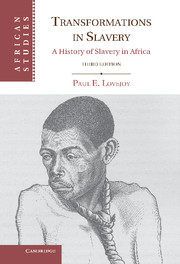Book contents
- Frontmatter
- Contents
- Maps and Tables
- Note on Currencies, Weights, and Measures
- Preface
- Preface to the Second Edition
- Preface to the Third Edition
- 1 Africa and Slavery
- 2 On the Frontiers of Islam, 1400–1600
- 3 The Export Trade in Slaves, 1600–1800
- 4 The Enslavement of Africans, 1600–1800
- 5 The Organization of Slave Marketing, 1600–1800
- 6 Relationships of Dependency, 1600–1800
- 7 The Nineteenth-Century Slave Trade
- 8 Slavery and “Legitimate Trade” on the West African Coast
- 9 Slavery in the Savanna during the Era of the Jihads
- 10 Slavery in Central, Southern, and Eastern Africa in the Nineteenth Century
- 11 The Abolitionist Impulse
- 12 Slavery in the Political Economy of Africa
- Epilogue
- Appendix Chronology of Measures against Slavery
- Notes
- Select Bibliography
- Index
- Books in this series
1 - Africa and Slavery
Published online by Cambridge University Press: 05 June 2012
- Frontmatter
- Contents
- Maps and Tables
- Note on Currencies, Weights, and Measures
- Preface
- Preface to the Second Edition
- Preface to the Third Edition
- 1 Africa and Slavery
- 2 On the Frontiers of Islam, 1400–1600
- 3 The Export Trade in Slaves, 1600–1800
- 4 The Enslavement of Africans, 1600–1800
- 5 The Organization of Slave Marketing, 1600–1800
- 6 Relationships of Dependency, 1600–1800
- 7 The Nineteenth-Century Slave Trade
- 8 Slavery and “Legitimate Trade” on the West African Coast
- 9 Slavery in the Savanna during the Era of the Jihads
- 10 Slavery in Central, Southern, and Eastern Africa in the Nineteenth Century
- 11 The Abolitionist Impulse
- 12 Slavery in the Political Economy of Africa
- Epilogue
- Appendix Chronology of Measures against Slavery
- Notes
- Select Bibliography
- Index
- Books in this series
Summary
Slavery has been an important phenomenon throughout history. It has been found in many places, from classical antiquity to very recent times. Africa has been intimately connected with this history, both as a major source of slaves for ancient civilizations, the Islamic world, India, and the Americas, and as one of the principal areas where slavery was common. Indeed, in Africa slavery lasted well into the twentieth century – notably longer than in the Americas. Such antiquity and persistence require explanation, both to understand the historical development of slavery in Africa in its own right and to evaluate the relative importance of the slave trade to this development. Broadly speaking, slavery expanded in at least three stages – 1350 to 1600, 1600 to 1800, and 1800 to 1900 – by which time slavery had become a fundamental feature of the African political economy. This expansion occurred on two levels that were linked to the external slave trade. First, slavery became more common over an increasingly greater geographical area, spreading outward from those places that participated directly in the external slave trade. Second, the role of slaves in the economy and society became more important, resulting in the transformation of the social, economic, and political order. Again, the external trade was associated with this transformation.
Slavery: A Definition
Slavery is one form of exploitation. Its special characteristics include the idea that slaves are property; that they are outsiders who are alien by origin or who are denied their heritage through judicial or other sanctions; that coercion can be used at will; that their labor power is at the complete disposal of a master; that they do not have the right to their own sexuality and, by extension, to their own reproductive capacities; and that the slave status is inherited unless provision is made to ameliorate that status. These various attributes need to be examined in greater detail to clarify the distinctions between slavery and other servile relationships.
- Type
- Chapter
- Information
- Transformations in SlaveryA History of Slavery in Africa, pp. 1 - 23Publisher: Cambridge University PressPrint publication year: 2011
- 1
- Cited by



